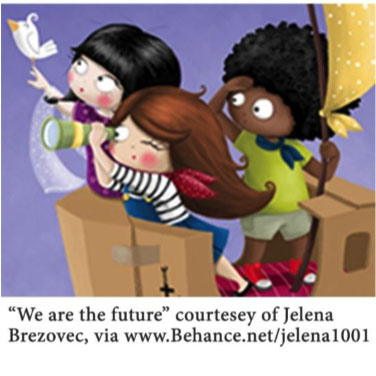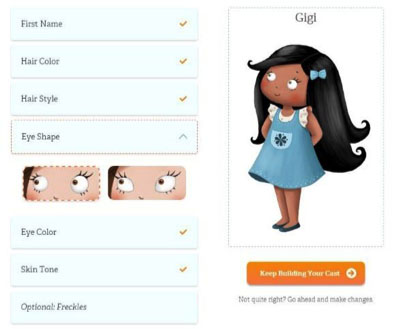The first personalized children’s books that were available when I was a child allowed for little more than a dedication to the child in the front of the book. More recently, personalized books for kids have included storylines consisting of loosely-woven lines that spell a child’s name.

Breaking from those traditions, my line of award-winning bilingual and single-language personalized children’s books are tailored for one special child. Up to five of the child’s family members appear in the book, and the appearance of each of the book’s characters is customizable. The end result is a cast of characters that truly resembles the child and his/her loved ones. As a result, Snowflake Stories personalized children’s books are great for bilingual, multiracial, and non-traditional families, as well as families that adopt.
How the Concept Began: It all started with the story
All of this customization wasn’t part of my original plan. So, what was the original plan? From the start, I knew that I wanted to write a bilingual book, and I knew that I wanted to write engaging stories. And before I began writing, I decided that a book that had a child’s name printed on the pages would really help that child to see himself/herself in the story.
The first storylines that came to me were ones that revolved around young children’s activities, such as dance and soccer. I was just playing around with phrases about dance and the Dance Recital book’s first two lines popped into my head:
Gigi Barletti was a pretty, young girl.
Whenever she heard music she would dance and twirl.
Gigi Barletti era una niña muy bonita.
Siempre bailaba cuando escuchaba musiquita.
I decided to continue working on the Dance Recital book because I have always felt that there are more good books and toys for boys than there are for girls. I guess the idea that a young girl might be nervous for her upcoming dance recital came to me because I took dance class as a child and could relate to that feeling.
Somehow, the storylines also included several of the child’s family members. I’m not sure if that was because of my own close relationship with my children, or if it stemmed from one of the many characteristics of Latino cultures that I have admired: importance of family, or if it was because in a child’s world, parents and other family members play a central role. Whatever the reason was for including the child’s loved ones in the storyline, I did. It wasn’t until I read the story aloud that I realized that my own book didn’t reflect my family! I knew that some divorced parents may not want to include the other parent when creating a book. It also occurred to me that children of same sex couples would be frustrated if they were to receive a book with a mom and a dad. So, I decided that when creating a book for one special child, the book’s creator must be able to choose which characters to include in the story.
This book has so much customization, how are we going to illustrate it?!?!
With those decisions made, my thoughts turned to how the illustrator would handle the illustrations. I knew that I didn’t to showcase characters with traits that nobody really has, such as characters with raspberry-colored hair; nor did I want to somehow hide the appearance of the characters behind a cape or hat. My first thought was to create a several books each with a different main character who would represent a particular ethnicity. I thought that might work until my kids asked me what the parents would look like. Puzzled, I thought for a minute before suggesting that the children would look like their parents, meaning that lighter-skinned children with brown eyes and brown hair would have parents who looked the same … until I realized that neither my kids’ father nor I looked like that! Nor would it work for me, as my dad has blue eyes and my mom has green, and neither one has blond hair like I do. It was then that I decided that each character’s appearance needed to be completely customizable.

With a clear vision for the illustrations, I set out to find an illustrator, which was actually a very difficult task! I had to love the work, the illustrator had to be available in the not-so-distant future, and he/she had to be willing to create all of the art required for my highly customizable children’s picture book. It took me six months before I found Jelena—six months of looking through portfolios for hours almost daily. I’ll admit, I did reach out to more than a handful of illustrators before I contacted Jelena. A few didn’t “get” the project, but most simply weren’t interested in spending the additional time required to make all of the different characters I wanted to offer. My search for the perfect illustrator was a lesson in patience, and I’m glad that I didn’t settle. When I saw Jelena’s portfolio, I fell in love with her work; Jelena’s “Love” and “Neva” illustrations were two of my favorites, but the picture convinced me that Jelena was the perfect illustrator for my book was “We are the future.”
Selecting the Features
Even though Jelena loved the idea of providing children with a book filled with characters that actually looked like them and their families, I silently feared that if I requested too many different features, she might feel overwhelmed by the amount of work and would walk away from the project. I also knew that there were serious budget constraints—I was bootstrapping (self-funded) and simply couldn’t afford to pay for every possible hairstyle and skin color under the sun. So, I decided to have faith in my illustrator and allowed her to create, as I believe that fostering an artist’s freedom to create is the way to get his/her best work. I really tried to allow Jelena to create the different hairstyles and colors. We did have long email dialogues, in which I shared links to images of certain celebrities, so she could tweak hairstyles a bit. (Did I mention that since Jelena lives in Croatia, we communicated solely via email to complete our first book?)
Skin color was a little trickier because in Croatia, Jelena is exposed to a predominantly white population. Since kid lit is overwhelmingly filled with white characters, I felt strongly about trying to offer quality skin color options for people whose skin isn’t porcelain. Together, we looked at Iman Cosmetics to help us select different skin colors for the illustrations. We tried to find representative shades for Iman’s Sand, Clay, and Earth product classifications, which Jelena tried to replicate in her own collection of color swatches. (Note: the Iman Cosmetics website has changed since we were researching skin tones. At that time, there were galleries of about 20 (gorgeous!) models for each of the makeup categories, which showed the spectrum of skin tones that each of the Sand, Clay, and Earth product categories covered.)
How to show customers all the features?

It took several months, but once Jelena had finished all of the illustrations, the next big hurdle was figuring out how customers would include just the right characters in their books. Snowflake Stories’ website developer James Stone and I had several discussions about how to handle this, and decided that instead of filling out a long, boring questionnaire, creating a character in real time, onscreen through a selection of physical traits was the way to go. The end result was our proprietary Character Builder, for which James deserves a great deal of the credit for designing; the Character Builder makes tailoring the appearance of the characters fun and easy. Visitors to the Snowflake Stories website create each character with just a few clicks of the mouse, selecting traits, such as skin color, hair style, and eye color. The result? An entire cast of characters that truly resembles that one special child and family members.
Now, with my new line of personalized books for kids, biracial, multiracial, bilingual, and non-traditional families, as well as families that adopt have more options for their own libraries.
